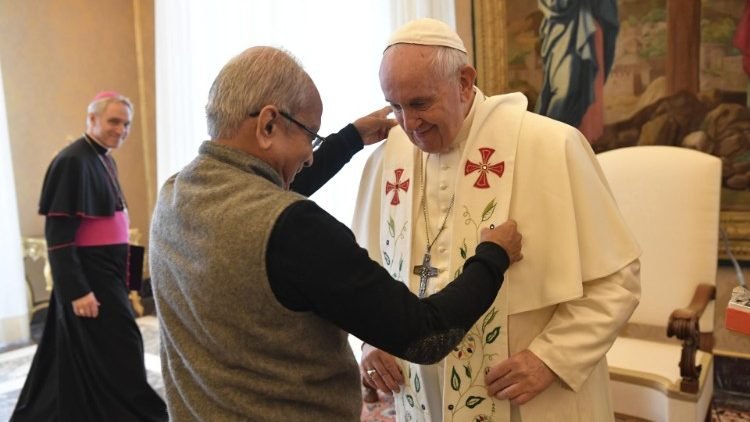The “Tree of Life” symbolizes the interconnected nature of all things in the universe. Fr Cedric Prakash SJ, who recently had the occasion to meet Pope Francis in the Vatican, explains why he chose this symbol as a gift for the Pope.
By Linda Bordoni
The Tree of Life is depicted as a large tree with roots that spread inward to the ground and branches that spread outward to the sky. It represents the interconnected nature of all things in the universe and celebrates unity in diversity.
It is also the symbol of the Indian city of Ahmenabad in Gujarat state where the 16th century Sidi Saiyyed Mosque features ten beautiful stone latticework windows featuring the delicately carved Tree.
It’s also where Jesuit Fr. Cedric Prakash, founder and Director of PRASHANT, the Ahmedabad based Jesuit Centre for Human Rights, Justice and Peace currently lives and works.
Last week he was in Rome for a 2-Day Forum of Catholic-inspired NGOs that wrapped up with a papal audience.
Afterwards, Father Cedric took time to pop into Vatican Radio and spoke to us about his feelings when meeting Pope Francis and about that special gift he brought from India:Listen to the interview with Fr Cedric Prakash SJ
Describing his meeting with Pope Francis as one of the great and memorable moments of his life, Father Cedric explained that after his “inspiring and meaningful” address, in which the Pope told those present to go forward in their work with courage and with hope, he also took time to meet personally with those present.
“I carried with me two things: one was a replica of the Tree of Life, the other a stole embroidered with the Tree of Life,” Father Cedric said.
The stole, he explained, was made by women from the slums in Ahmedabad who work at St. Mary’s training center for women. They do excellent embroidery and train women to earn their livelihoods
Before coming to Rome, the Jesuit priest said, “I spoke to the director of the center, Sr. Silvia, and told her I may have the possibility of meeting the Pope and I would like to give him a stole with the Tree of Life, and she had it done.”
Father Cedric told me of the Pope’s reaction to the gift and of how he described it as a “stola magnifica, elegante,” immediately asking Father Cedric to put it on him.
“The way he responded to the stole and the way he looked at the replica of the Tree of Life was a moment I will never forget,” he said.
Like St. Ignatius, Father Cedric said, Pope Francis has “has set the world on fire: he has taken a stand for the poor, the marginalized, the excluded, for those who nobody wants.”
For me, he continued, that is “the Ignatian vision, the Ignatian ideal,” and it is what all of us are asked to do in order to “live the person and message of Jesus in today’s world.”
Reflecting on Pope Francis’ deep sense of humanity and capacity to really connect with those he engages with, he noted that during the audience he set aside his prepared speech and spoke from the heart.
And then, he really took the time to engage personally with those present with the “tremendous capacity of a human being to be Jesus in today’s world”.
The Tree of Life
The Tree of Life, that Father Cedric chose as a symbol for his gift to Pope Francis, is as old as the Society of Jesus, he said.
The original representation, he explained, is in a mosque in the center of Ahmedabad, built by the Sultan Ahmed Shah, a great ruler who chose that particular place on the banks of the river Sabarmati to found the city because, according to a legend he saw dogs, rabbits and hares playing there together.
“He decided if this is a place where they can play together it is where I shall build my new capital,” Father Cedric narrated, explaining that one of the first things the Sultan did was to build a temple for his Hindu wife “so that she could have a place in which to worship.” Later, the mosque was built and skilled artisans and artists from Yemen or from Abyssinia came to carve the stone trellis “which is a masterpiece”.
“It is reflective of what Jesus tells us: I am the vine and you are the branches,” he said.
The fact, Father Cedric continued, that we are all interrelated, “regardless of who we are and where we come from, regardless of our ethnicity, our faith, our ideology, our religion or the colour of our skin: as Jesus tells us we are all created in the likeness of God and we are one family.”
This is what Pope Francis insists upon, Father Cedric reminded me, that we are one human family: “those who are excluded, those who are migrants, those who are refugees, are one of us. Let’s not exclude them.”
And that, he concluded, was also the theme of the Forum that took place in Rome last week.



